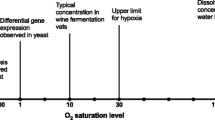Abstract
The effects of potassium tellurite on growth and survival of rho+ and rho0 Saccharomyces cerevisiae strains were investigated. Both rho+ and rho0 strains grew on a fermentable carbon source with up to 1.2 mM K2TeO3, while rho+ yeast cells grown on a non-fermentable carbon source were inhibited at tellurite levels as low as 50 μM suggesting that this metalloid specifically inhibited mitochondrial functions. Growth of rho+ yeast cells in the presence of increasing amount of tellurite resulted in dose-dependent blackening of the culture, a phenomenon not observed with rho0 cultures. Transmission electron microscopy of S. cerevisiae rho+ cells grown in the presence of tellurite showed that blackening was likely due to elemental tellurium (Te0) that formed large deposits along the cell wall and small precipitates in both the cytoplasm and mitochondria.

Similar content being viewed by others
References
Baesman SM, Bullen TD, Dewald J, Zhang D, Curran S, Islam FS, Beveridge TJ, Oremland RS (2007) Formation of tellurium nanocrystals during anaerobic growth of bacteria that use Te oxyanion as respiratory electron acceptors. Appl Environ Microbiol 73:2135–2143. doi:10.1128/AEM.02558-06
Borghese R, Borsetti F, Foladori P, Ziglio G, Zannoni D (2004) Effects of the metalloid oxyanion tellurite (TeO3 2−) on growth characteristics of the phototrophic bacterium Rhodobacter capsulatus. Appl Environ Microbiol 70:6595–6602. doi:10.1128/AEM.70.11.6595-6602.2004
Borghese R, Marchetti D, Zannoni D (2008) The highly toxic oxyanion tellurite (TeO3 2−) enters the phototrophic bacterium Rhodobacter capsulatus via an as yet uncharacterized monocarboxylate transport system. Arch Microbiol 189:93–100. doi:10.1007/s00203-007-0297-7
Cooper WC (1971) Tellurium. Van Nostrand Renhod Co, New York
Csotonyi JT, Stackebrandt E, Yurkov V (2006) Anaerobic respiration on tellurate and other metalloids in bacteria from hydrothermal vent fields in the eastern Pacific Ocean. Appl Environ Microbiol 72:4950–4956. doi:10.1128/AEM.00223-06
Del Giudice L, Massardo DR, Pontieri P, Wolf K (2005) Interaction between yeast mitochondrial and nuclear genomes: Null alleles of RTG genes affect resistance to the alkaloid lycorine in rho0 petites of Saccharomyces cerevisiae. Gene 354:9–14. doi:10.1016/j.gene.2005.03.020
Gharieb MM, Gadd GM (1998) Evidence for the involvement of vacuolar activity in metal (loid) tolerance: vacuolar-lacking and -defective mutants of Saccharomyces cerevisiae display higher sensitivity to chromate, tellurite and selenite. Biometals 11:101–106. doi:10.1023/A:1009221810760
Lloyd JR (2003) Microbial reduction of metals and radionuclides. FEMS Microbiol Rev 27:411–425. doi:10.1016/S0168-644(03)00044-5
Ollivier PR, Bahrou AS, Marcus S, Cox T, Church TM, Hanson TE (2008) Volatilization and precipitation of tellurium by aerobic, tellurite-resistant marine microbes. Appl Environ Microbiol 74:7163–7173. doi:101128/AEM.00733-08
Taylor DE (1999) Bacterial tellurite resistance. Trends Microbiol 7:111–115. doi:10.1016/S0966-842X(99)01454-7
Taylor DE, Hou Y, Turner RJ, Weiner JH (1994) Location of a potassium tellurite resistance operon (tehAtehB) within the terminus of Escherichia coli K-12. J Bacteriol 176:2740–2742
Toptchieva A, Sisson G, Bryden LJ, Taylor DE, Hoffman PS (2003) An inducible tellurite-resistance operon in Proteus mirabilis. Microbiology 149:1285–1295. doi:10.1099/mic.0.25981-0
Trutko SM, Akimenko VK, Suzina NE, Anisimova LA, Shlyapnikov MG, Baskunov BP, Duda VI, Boronin AM (2000) Involvement of the respiratory chain of gram-negative bacteria in the reduction of tellurite. Arch Microbiol 173:178–186. doi:10.1007/S002039900123
Turner RJ, Aharonowitz Y, Weiner JH, Taylor DE (2001) Glutathione is a target in bacterial tellurite toxicity and is protected by tellurite resistance determinants in Escherichia coli. Can J Microbiol 47:33–40
Zannoni D, Borsetti F, Harrison JJ, Turner RJ (2008) The bacterial response to the chalcogen metalloids Se and Te. Adv Microb Physiol 53:1–72. doi:10.1016/S0065-2911(07)53001-8
Acknowledgments
The research was supported by Compagnia di San Paolo special grant “iniziativa” to L. Del Giudice. P. Pontieri was supported by a postdoctoral grant from the Istituto Banco di Napoli, Fondazione.
Author information
Authors and Affiliations
Corresponding author
Rights and permissions
About this article
Cite this article
Massardo, D.R., Pontieri, P., Maddaluno, L. et al. Effects of tellurite on growth of Saccharomyces cerevisiae . Biometals 22, 1089–1094 (2009). https://doi.org/10.1007/s10534-009-9259-7
Received:
Accepted:
Published:
Issue Date:
DOI: https://doi.org/10.1007/s10534-009-9259-7




